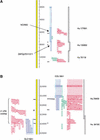Long-range heterogeneity at the 3' ends of human mRNAs
- PMID: 12097343
- PMCID: PMC186619
- DOI: 10.1101/gr.62002
Long-range heterogeneity at the 3' ends of human mRNAs
Abstract
The publication of a draft of the human genome and of large collections of transcribed sequences has made it possible to study the complex relationship between the transcriptome and the genome. In the work presented here, we have focused on mapping mRNA 3' ends onto the genome by use of the raw data generated by the expressed sequence tag (EST) sequencing projects. We find that at least half of the human genes encode multiple transcripts whose polyadenylation is driven by multiple signals. The corresponding transcript 3' ends are spread over distances in the kilobase range. This finding has profound implications for our understanding of gene expression regulation and of the diversity of human transcripts, for the design of cDNA microarray probes, and for the interpretation of gene expression profiling experiments.
Figures

References
-
- Aaronson JS, Eckman B, Blevins RA, Borkowski JA, Myerson J, Imran S, Elliston KO. Toward the development of a gene index to the human genome: An assessment of the nature of high-throughput EST sequence data. Genome Res. 1996;6:829–845. - PubMed
-
- Burge CB. Chipping away at the transcriptome. Nat Genet. 2001;27:232–234. - PubMed
-
- Caron H, van Schaik B, van der Mee M, Baas F, Riggins G, van Sluis P, Hermus MC, van Asperen R, Boon K, Voute PA, et al. The human transcriptome map: Clustering of highly expressed genes in chromosomal domains. Science. 2001;291:1289–1292. - PubMed
Publication types
MeSH terms
Substances
LinkOut - more resources
Full Text Sources
Other Literature Sources
Research Materials
